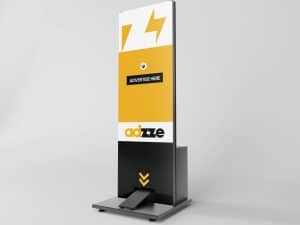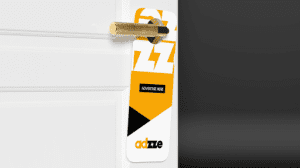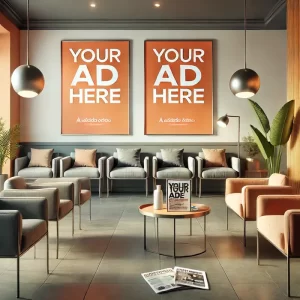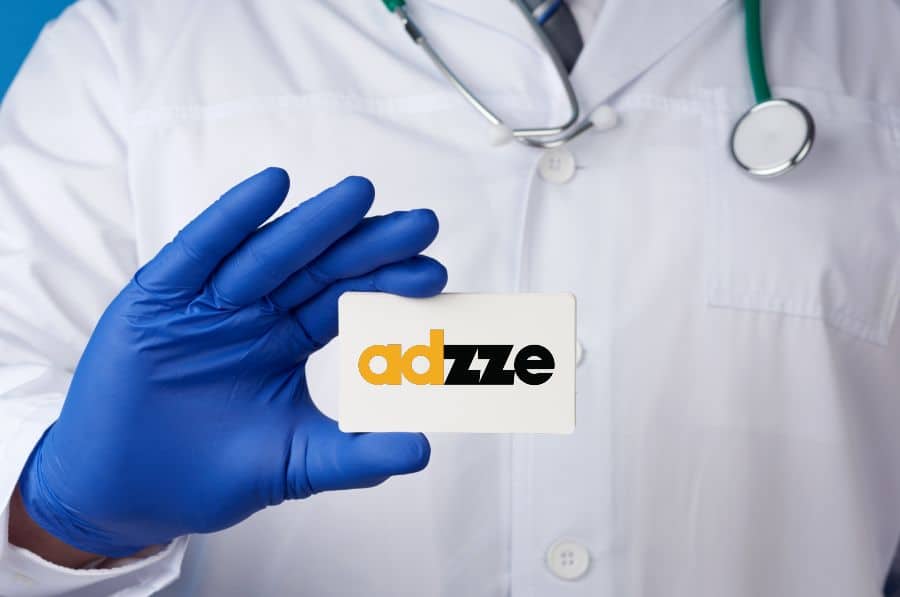The global healthcare market is expanding rapidly, driven by increasing consumer demand for wellness and preventive care, alongside a rise in disposable income. In this competitive and evolving landscape, successful healthcare advertising campaigns require innovative, sensitive, and health-focused strategies to engage audiences effectively. Traditional advertising methods, such as billboards and subway posters, are no longer sufficient to captivate today’s more health-conscious and pandemic-aware consumers, who seek personalized and context-driven messaging.
One creative and highly effective solution is advertising on hand sanitization stations, a strategy that capitalizes on high-traffic areas and health-conscious behaviors. Beyond sanitization stations, advertisers in the health care industry can also leverage in-hand advertising solutions, such as pharmacy and prescription bags, as well as placements within doctor’s offices. Let’s dive deeper into how these modern advertising trends are transforming healthcare advertising campaigns and how this industry can maximize their ROI using these approaches.
The Shifting Landscape of Advertising: From Traditional to Sensitive and Targeted
1. New Norms, New Challenges
The COVID-19 pandemic redefined consumer behaviors, making health and hygiene a central focus. This shift has significantly influenced advertising trends, moving away from conventional methods like billboards toward more thoughtful, context-driven campaigns.
Why Sensitivity Matters: In the wake of the pandemic, brands must demonstrate empathy and care in their messaging. Ads placed in health-centric environments, such as hand sanitization stations or doctor’s offices, inherently communicate a commitment to public well-being.
Adaptation to New Habits: Health-conscious consumers are now more attentive to hygiene and public health messaging, making advertising in these contexts not only impactful but also timely.
2. The Rise of High-Engagement Locations
High-traffic, health-focused areas like sanitization stations, pharmacies, and clinics have become invaluable for advertisers. These locations provide:
Relevance: Ads appear in spaces where consumers are already health-focused.
Engagement: Extended dwell time in these areas ensures greater exposure to the brand message.
The Power of Advertising on Hand Sanitization Stations
1. How It Works
Hand sanitization stations, whether manual or automated, are now ubiquitous in public spaces such as hospitals, eateries, colleges, and malls. These stations can serve as advertising platforms by incorporating:
Posters: Static visuals that deliver clear, concise messages.
Digital Screens: Interactive and dynamic displays for engaging video ads or scrolling text.
Branded Sanitizer Bottles: Customized dispensers featuring logos, slogans, or QR codes linking to promotional content.

2. Why It’s Effective
High Traffic: Sanitization stations attract repeated use, ensuring frequent exposure to advertisements.
Consumer Attention: The act of sanitizing hands is an intentional activity, making consumers more likely to notice nearby messaging.
Health-Centric Messaging: By advertising at sanitization stations, brands align themselves with safety, hygiene, and care, building trust with their audience.
3. Strategic Placement for Maximum Impact
To maximize effectiveness, ads on sanitization stations must be placed strategically in:
Entry and Exit Points: High-traffic locations where hand sanitization is routine, such as building lobbies or hospital entrances.
Waiting Areas: Clinics and pharmacies, where patients have time to absorb messages.
Educational Institutions: Colleges and universities, where younger audiences can be targeted with wellness-related campaigns.
Beyond Sanitization Stations: Leveraging In-Hand Advertising
In-hand advertising focuses on placing branded materials directly into the consumer’s hands, creating a physical connection that enhances brand recall. For healthcare advertising campaigns, this can include:

1. Pharmacy Bags and Prescription Bags
Pharmacy and prescription bags are excellent tools for reaching health-conscious consumers. Patients receive these bags when picking up medications, ensuring direct interaction with the brand message.
Example: A med spa could use prescription bags to promote a discount on skincare treatments, featuring QR codes that link to booking pages or educational content about the benefits of facials.
2. Branded Hand Sanitizers
Custom hand sanitizers distributed in clinics, gyms, or wellness centers not only provide a practical benefit but also reinforce brand messaging every time the consumer uses the product.
Example: A med spa specializing in anti-aging treatments could provide hand sanitizers with messaging like “Stay Safe, Stay Youthful” and include a QR code for booking consultations.

3. Door Hanger Advertising
For healthcare advertising campaigns near residential areas, door hangers can announce new services, special promotions, or upcoming events. These physical touchpoints ensure visibility in a clutter-free environment.
Example: A med spa could distribute door hangers promoting an open house event, offering free consultations or mini-treatments.
Doctor’s Office Advertising: Capturing a Captive Audience
Doctor’s offices are ideal for health-focused advertising due to the high dwell time and trust associated with medical environments.

1. Waiting Room Media
Patients spend significant time in waiting rooms, making this an excellent opportunity for targeted messaging.
Print Media: Posters, brochures, and magazines featuring wellness tips or med spa promotions.
Digital Screens: Dynamic ads showcasing video testimonials or before-and-after visuals of treatments offered at the med spa.
2. Examination Room Placements
Branded materials within examination rooms can provide more intimate and targeted engagement.
Branded Exam Table Covers: Highlighting specific services like chemical peels or microdermabrasion.
Educational Materials: Brochures about wellness programs or anti-aging solutions offered by the med spa.
Case Studies: Real-Life Success with Health Ad Campaigns
1. Hand Sanitizer Advertising at Hospitals
A wellness brand partnered with hospitals to distribute branded hand sanitizers. The campaign included QR codes linking to an educational blog about stress management. Within three months, the brand saw a 20% increase in website traffic and a 15% rise in inquiries about wellness programs.
2. Pharmacy Bag Campaign for Skincare Products
A skincare company advertised on pharmacy bags, promoting their anti-aging line. The bags featured a QR code for a 10% discount on first-time purchases. The campaign resulted in a 30% increase in sales within the first quarter.
3. Digital Waiting Room Ads for Weight Loss Programs
A med spa ran digital ads in doctor’s office waiting rooms, showcasing testimonials from clients who had successfully completed their weight loss programs. The campaign led to a 25% uptick in consultation bookings.
Innovating Health Advertising for Maximum Impact
Health advertising is no longer about generic messages plastered on billboards. To truly resonate with today’s health-conscious consumers, healthcare advertising campaigns must adopt sensitive, creative, and targeted strategies. From advertising on hand sanitization stations to leveraging pharmacy bags and doctor’s office media, the opportunities are vast.
At Adzze, we specialize in In-Hand Advertising solutions, turning common touchpoints—like design sheets, coffee sleeves, and shopping bags—into powerful marketing channels. Ready to make your brand unforgettable? Request our media kit today and see how our innovative strategies can elevate your next campaign. Check out the video below for a glimpse into the future of advertising!






